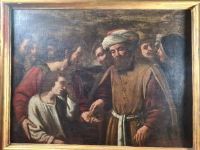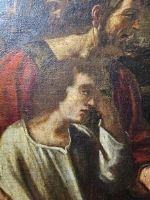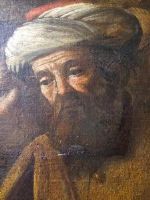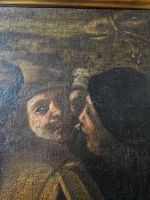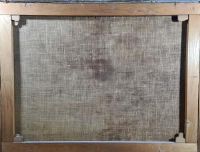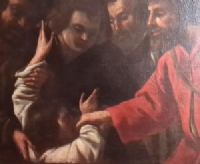Item : 435724
PENDANT OF TWO PAINTINGS. "JOSEPH SOLD BY HIS BROTHERS, the payment and delivery to the merchant".
Author : SCUOLA GENOVESE DEL XVII SECOLO
Period: 17th century
17TH CENTURY GENOESE SCHOOL.
Pendant paintings, oil on re-lined canvas.
A cleaning restoration would make the paintings more legible and increase their commercial value. Canvas dimensions 72x97 cm, with frame 90x114 cm.
PICTORIAL ANALYSIS
Joseph sold by his brothers is a widespread pictorial subject in the 17th-century Genoese school with works attributed to various artists, including Domenico Fiasella, Giovanni Andrea De Ferrari, and Luca Saltarello. The 17th-century Genoese school was able to excellently capture the emotions and intimacy of religion.
The artist of these two works is understandably linked to the prominence of the great Genoese Baroque decoration. These images, energetically enveloped by a naturalistic chiaroscuro dominated by brown and intense tones (a characteristic recovery of "Caravaggism"), represent a drama at its peak: Joseph, Jacob's favorite son, is sold by his brothers to a caravan of Ishmaelite merchants traveling to Egypt (Genesis, 37:12-28).
The rapid brushstrokes that describe the exotic clothes and headdresses give body and structure to the pictorial material: The camel depicted in the background in painting No. 2 is a clear reference to the passage of the merchant caravan.
Here, the artist has undoubtedly chosen a reduced chromatic scale to adapt to the gloomy atmosphere of this family tragedy inspired by the Old Testament.
The close-up framing with the half-length figures and the expressive gestures are stylistic characteristics of our artist who manifests in this work a silent, rather than spectacular, Baroque, in accordance with the contained pain of little Joseph.
BIBLICAL REFERENCES
In the two paintings, the episode of the sale of Joseph is described as a cinematic sequence: in the first, the brothers receive the money from the merchants, in the second, the merchants take him away.
This way of representing the scene suggests that the two works were part of a larger cycle, describing the entire and complex story of Joseph.
In the first painting, we notice how the painter has been able to describe in the faces of the brothers the mixture of satisfaction and greed and in that of the merchant a sort of compassion towards the child.
In the second, the scene gains movement, and the bewilderment of the child, who almost incredulously tries to cling to one of his brothers, is well described.
In this pendant, an episode of the story of Joseph inspired by "Genesis 37" is narrated, according to the dissemination of the Jahwist tradition, which sees the direct sale by the brothers and not the more official Elohist one, which reads:
They saw him from afar, and before he came near to them they conspired against him to kill him.
They said to one another, “Here comes this dreamer! Come now, let us kill him and throw him into one of the pits! Then we will say, ‘A wild beast has devoured him!'… Then Judah said to his brothers, “What profit is it to kill our brother and conceal his blood? Come, let us sell him to the Ishmaelites, and let not our hand be upon him, for he is our brother, our own flesh.”
And his brothers listened to him. Then Midianite traders passed by. And they drew Joseph up and lifted him out of the pit, and sold him to the Ishmaelites for twenty shekels of silver.
Thus Joseph was brought to Egypt.


